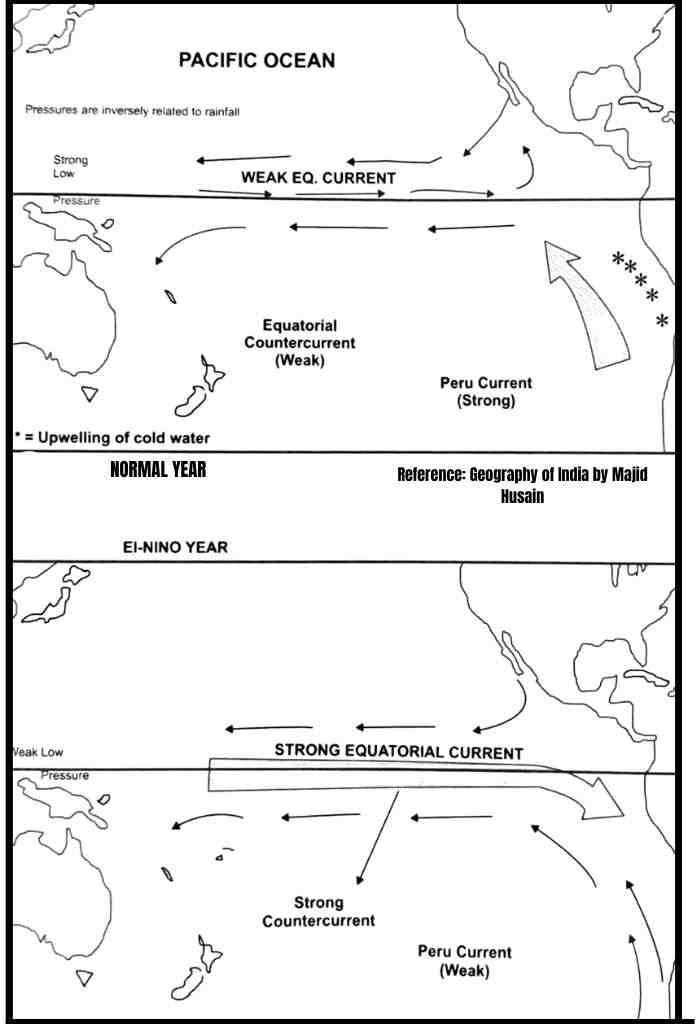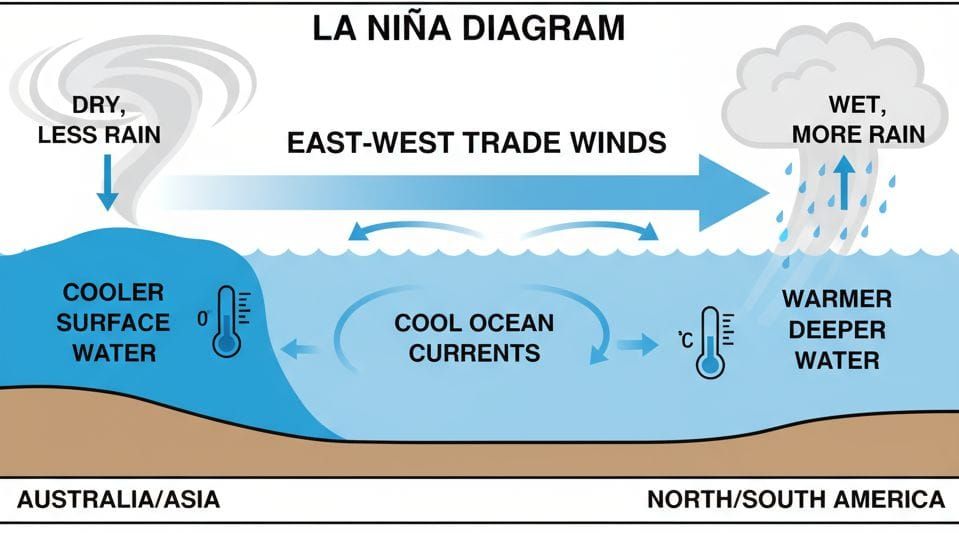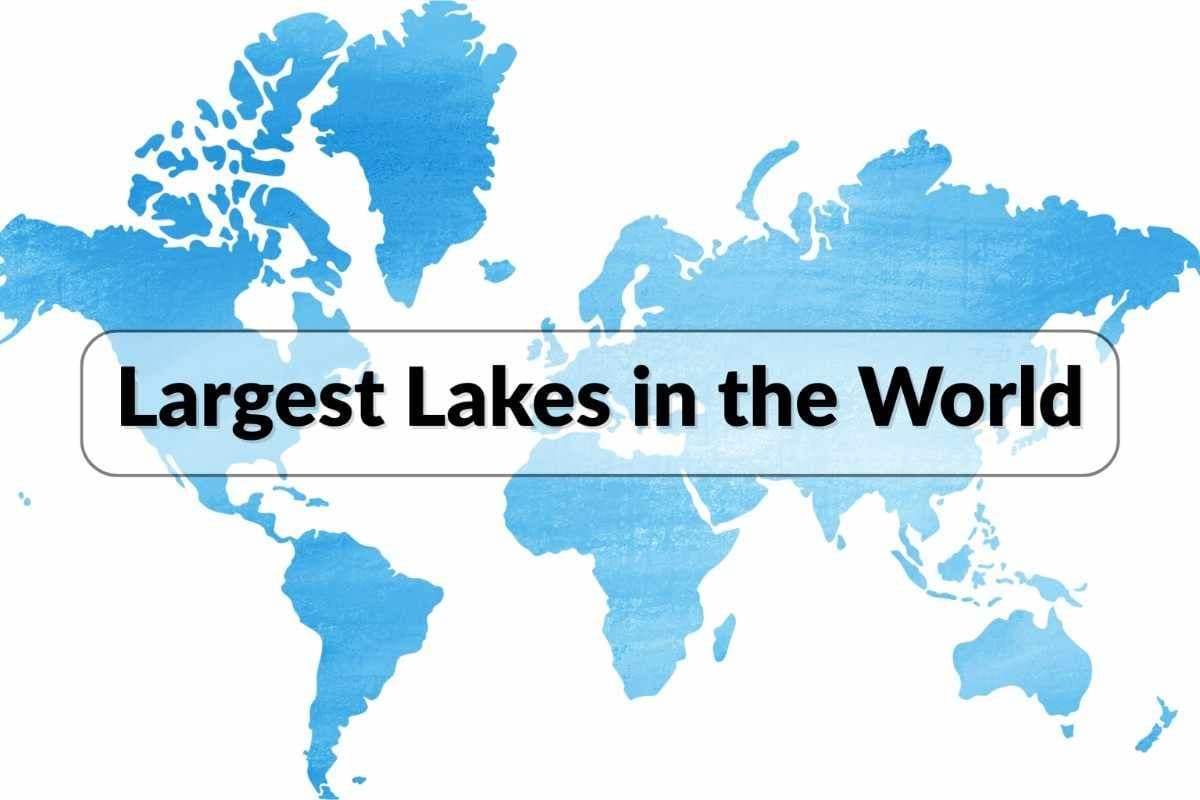El NINO and LA NINA UPSC Notes: Meaning, Impact and Important Terms
Oct, 2025
•4 min read
El Nino and La Nina are two of the most powerful natural climate phenomena that influence weather patterns across the globe. For India, these oceanic events directly impact the monsoon season, agricultural productivity, and economic growth.
Understanding these climate patterns is essential for UPSC aspirants, particularly for the Geography and Environment sections of GS Paper 1, as well as for linking concepts with current affairs and climate change initiatives.
What is El Nino?
El Nino is a climate phenomenon characterised by the warming of sea surface temperatures in the central and eastern equatorial Pacific Ocean. This warming disrupts normal weather patterns across the globe.

- EL Nino is also known as "The Little Boy" or "Christ Child" in Spanish.
- Occurs irregularly every three to seven years.
- Typically lasts between nine to eighteen months.
- Involves warming of ocean temperatures by at least 0.5°C above normal for five consecutive three-month periods.
- Associated with weakened trade winds in the Pacific Ocean.
- Peaks during the northern hemisphere winter (November to January).
- Generally brings below-normal rainfall to India during the monsoon season.
- It can cause droughts in Southeast Asia, Australia, and Indonesia.
- Often leads to increased rainfall in Peru, Ecuador, and the Southern United States.
Also read: Samudrayaan Mission: India’s Journey into the Deep Ocean
What is La Nina?
La Nina is a climate phenomenon characterised by the cooling of sea surface temperatures in the central and eastern equatorial Pacific Ocean. It represents the opposite phase of El Nino.

- La Nina means "The Little Girl" in Spanish. It is also sometimes called "El Viejo" (the old man) or simply "a cold event."
- Occurs every two to seven years, often following an El Nino event.
- It can last between one to three years, sometimes longer than El Niño.
- Involves cooling of ocean temperatures by at least 0.5°C below normal for five consecutive three-month periods.
- Associated with stronger-than-normal trade winds across the Pacific Ocean.
- Results in increased upwelling of cold, nutrient-rich water along South America's coast.
- Generally brings above-normal rainfall to India during the monsoon season.
- It can cause heavy rainfall and flooding in Southeast Asia and Australia.
- Often leads to drought conditions in Peru and Ecuador
What is ENSO (El Nino-Southern Oscillation)?
The El Nino-Southern Oscillation (ENSO) is a recurring natural climate phenomenon that involves fluctuating ocean temperatures and atmospheric pressure patterns across the equatorial Pacific Ocean.
- ENSO has two oceanic components: El Nino (warm phase) and La Nina (cold phase).
- The Southern Oscillation is the atmospheric counterpart that couples with ocean temperature changes.
- ENSO is one of the most important drivers of global climate variability
- It affects weather patterns across the globe through atmospheric teleconnections.
- ENSO cycles are not perfectly regular but show some pattern over the years.
Also read: Soils of India: Classification, Significance & Recent Crisis
Climate Patterns: Normal, El Nino, and La Nina Phases
Understanding the three phases of ENSO is essential for comprehending how these phenomena develop and impact global weather.
1. Normal Conditions (ENSO-Neutral Phase)
During normal or neutral conditions, the Pacific Ocean displays typical patterns of temperature distribution and wind circulation without significant anomalies. Key characteristics include:
- Trade winds blow steadily from east to west across the equatorial Pacific Ocean.
- Warm surface water is pushed toward the western Pacific near Indonesia and Australia.
- The sea level is approximately 0.5 meters higher in the western Pacific compared to the eastern Pacific.
- Cold, nutrient-rich water rises to the surface (upwelling) along the coast of South America.
- Walker Circulation operates normally with rising air in the western Pacific and descending air in the eastern Pacific.
- Sea surface temperatures are about 14°F (8°C) warmer in the western Pacific than in the eastern Pacific.
- The thermocline (boundary between warm surface water and cold deep water) is deeper in the west and shallower in the east.
- Normal monsoon patterns prevail across the Indian Ocean and Asia.
2. El Nino Phase (Warm Phase)
El Nino develops when trade winds weaken or even reverse, allowing warm water to spread eastward across the Pacific Ocean. Key characteristics include:
- Trade winds weaken significantly or may even reverse direction.
- Warm surface water that normally accumulates in the western Pacific flows eastward toward South America.
- Sea surface temperatures in the central and eastern Pacific Ocean rise by 1°C to 3°C above normal.
- The thermocline deepens in the eastern Pacific, reducing upwelling of cold water.
- Atmospheric pressure increases over Indonesia and Australia.
- Atmospheric pressure decreases over the eastern Pacific.
- The warm pool of water shifts from the western Pacific to the central and eastern Pacific.
- Convection and rainfall patterns shift eastward, bringing rain to normally dry regions of Peru and Ecuador.
3. La Nina Phase (Cold Phase)
La Nina occurs when trade winds strengthen beyond normal levels, intensifying the typical Pacific Ocean circulation patterns. Key characteristics include:
- Trade winds strengthen significantly, becoming more powerful than normal.
- Enhanced westward movement of warm surface water toward Indonesia and Australia.
- Sea surface temperatures in the central and eastern Pacific Ocean fall by 1°C to 3°C below normal.
- Increased upwelling of cold, nutrient-rich water along the coast of South America.
- The thermocline becomes shallower in the eastern Pacific.
- Atmospheric pressure decreases over Indonesia and the western Pacific.
- Atmospheric pressure increases over the eastern Pacific.
- Enhanced convection and rainfall over the western Pacific and Southeast Asia
- The warm water pool in the western Pacific becomes warmer and deeper than normal.
Also read: Bharat Forecast System: Launch, Objectives & Key Details
What is the Impact of El Nino and La Nina on India?
Both El Nino and La Nina significantly affect India's climate, agriculture, economy, and water resources. Let’s understand these impacts in detail.
Impact of El Nino on India
1. Monsoon and Rainfall:
- Weakens the southwest monsoon, leading to below-normal rainfall.
- Disrupts the normal east-to-west movement of moisture-laden winds.
- Causes the delayed onset of the monsoon season.
- Results in uneven distribution of rainfall across different regions.
- Historical droughts of 2002, 2009, 2014, and 2015 were all associated with El Nino years.
2. Agriculture:
- Reduces Kharif crop production, especially rice, pulses, maize, and oilseeds.
- Leads to low soil moisture levels and inadequate irrigation water.
- Causes crop stress, stunted growth, and poor yields.
- Worst-hit states include Punjab, Haryana, Uttar Pradesh, Bihar, Maharashtra, and Karnataka.
- Increases pest and disease proliferation due to favourable conditions
3. Temperature and Weather:
- Leads to higher-than-normal temperatures across India.
- Increases heat stress on crops and livestock.
- Creates drought-like conditions in many regions.
- It may reduce cyclonic storms in the Bay of Bengal.
- It can cause increased cyclones in the Arabian Sea due to warmer ocean temperatures.
4. Economic Impact:
- Reduces agricultural output, leading to increased food prices and inflation.
- Affects GDP growth as agriculture contributes significantly to India's economy.
- Increases rural poverty and distress among farmers.
- Impacts hydropower generation due to reduced water availability in reservoirs.
Impact of La Nina on India
1. Monsoon and Rainfall:
- Strengthens the southwest monsoon, leading to normal or above-normal rainfall.
- Enhances moisture convergence over the Indian subcontinent.
- Supports good agricultural productivity in most regions.
- It can cause excessive rainfall, leading to flooding in certain areas.
- Enhances the summer monsoon over Southeast Asia and the Indian subcontinent.
2. Agriculture:
- Boosts agricultural productivity, especially for rain-fed crops.
- Increases crop yields for Kharif season crops like rice, cotton, and sugarcane.
- Reduces dependency on irrigation systems.
- Lowers the need for food grain imports
- May damage crops like rice, sugarcane, and cotton in flood-affected areas.
- Beneficial for Northwest India and Bangladesh.
3. Temperature and Weather:
- Generally results in below-normal temperatures during the winter season.
- It can cause severe cold waves in northern India during winter.
- Increases cyclonic activity in the Bay of Bengal.
- It may pose threats to coastal infrastructure in states like Odisha, Andhra Pradesh, and Tamil Nadu.
- Brings enhanced rainfall during the post-monsoon season (October-November).
4. Economic Impact:
- Stabilises food prices due to increased agricultural output.
- Helps control inflation through abundant crop production.
- Boosts hydropower generation as reservoirs get replenished.
- Ensures sufficient groundwater recharge, benefiting water-scarce areas.
Multiple Choice Questions
QUESTION 1
Easy
With reference to El Niño, consider the following statements:
1.El Niño involves the appearance of a warm current on the coast of Peru in the eastern Pacific.
2.This warm current increases the temperature of the water on the Peruvian coast by 10 degrees Celsius, thereby increasing the amount of plankton in the sea.
Which statement(s) is/are correct?
Select an option to attempt
How El Nino and La Nina Impact the World
These climate phenomena affect weather patterns, agriculture, fisheries, and economies across the entire world.
Global Impact of El Nino
1. Regional Weather Impacts:
- South America: Heavy rainfall, flooding, and landslides in Peru and Ecuador; droughts in northern Brazil and Colombia.
- North America: Cool and wet winters in the southern United States; mild and dry conditions in the northern United States and Canada; increased atmospheric rivers on the West Coast.
- Australia and Southeast Asia: Severe droughts, heatwaves, and increased wildfire risk; reduced rainfall in Indonesia, the Philippines, and Malaysia.
- Africa: Droughts in southern Africa and Ethiopia; increased rainfall in East Africa (Kenya, Tanzania).
Pacific Islands: Changes in tropical cyclone patterns and reduced rainfall.
2. Fisheries and Marine Ecosystems:
- Reduced the upwelling of nutrient-rich water off the coast of Peru.
- Decline in fish populations, especially Peruvian anchoveta (the world's largest monospecific fishery).
- Peru's anchovy catch can decline by 50% or more during strong El Nino events.
3. Global Economic Impact:
- Affects food security for millions of people worldwide.
- Disrupts agricultural productivity and trade.
- Increases costs for disaster management and relief operations.
4. Atmospheric and Temperature Effects:
- El Nino years often produce some of the hottest years on record globally.
- Disrupts jet stream patterns, affecting weather in mid-latitude regions.
- Reduces Atlantic hurricane activity due to increased wind shear.
Global Impact of La Nina
1. Regional Weather Impacts:
- South America: Drought conditions in Peru and Ecuador; heavy rainfall and flooding in northern Brazil
- North America: Wetter and cooler conditions in the Pacific Northwest and Alaska; warmer and drier conditions in the southern United States; increased winter storm frequency in northern states
- Australia and Southeast Asia: Heavy rainfall and flooding, especially in Queensland, Australia and Indonesia; enhanced agricultural conditions but increased flood risk
- Africa: Increased rainfall in southeastern Africa; wetter conditions in East Africa can lead to flooding
- Pacific Islands: Increased tropical cyclone activity and elevated sea levels
2. Fisheries and Marine Ecosystems:
- Enhanced upwelling brings nutrient-rich water to the surface.
- Supports plankton growth and fish populations.
- Benefits of commercial fisheries off the coast of Peru and Chile.
3. Global Economic Impact:
- It can cause severe flooding with economic losses in Australia, Southeast Asia, and parts of South America.
- The 2010-2011 drought in the Horn of Africa (influenced by La Nina) affected over 13 million people.
- It can lead to humanitarian crises requiring international assistance.
4. Atmospheric and Temperature Effects:
- Enhances Atlantic hurricane activity due to reduced wind shear.
- Reduces Pacific hurricane and typhoon activity.
- Strengthens Walker Circulation, affecting global atmospheric patterns.
- Can contribute to more frequent tornadoes in the southeastern United States
UPSC Mains Practice Question
Discuss the causes and consequences of El Nino and La Nina, highlighting their impact on the Indian monsoon and agriculture.
Evaluate Your Answer Now!Way Forward
Understanding and preparing for ENSO events is crucial for mitigating their negative impacts and maximising the benefits.
- Adopt drought-resistant and flood-tolerant crop varieties.
- Guide crop selection based on ENSO forecasts.
- Develop contingency plans for different ENSO phases.
- Implement building codes for flood and cyclone-prone areas.
Unlock your UPSC potential with SuperKalam-get instant doubt resolution, personalised study plans, unlimited MCQ practice, and rapid Mains answer evaluation.
Join thousands of aspirants excelling with India’s leading AI-powered super mentor today!


